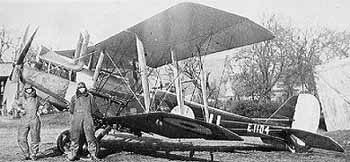|

During World War I, the lumbering Reconnaissance Experimental 8 was the
most widely used British two-seater biplane on the Western Front. A
descendant of the R.E.7, it was initially developed for reconnaissance
work but also saw service as a bomber and ground attack aircraft.
Nicknamed "Harry Tate," it provided a stable platform for photographic
missions but suffered from poor manoeuvrability, leaving it vulnerable
to attack by enemy fighters. Despite heavy losses, the R.E.8 remained
in service throughout the war.
On the morning of 13 April 1917, 59 Squadron's ill fated flight of six
R.E.8s was on a photo-reconnaissance mission near Douai when it
encountered Jasta 11. All six R.E.8s were shot down within a matter of
minutes, one of them becoming Manfred von Richthofen's forty first
victory.
Country: Great Britain
Manufacturer: Royal Aircraft Factory
Type: Reconnaissance/Bomber
Entered Service: Autumn 1916
Number Built: 4,099
Engine(s): Royal Aircraft Factory 4a, 12 cylinder, air-cooled, inline
V, 150 hp
Wing Span: 42 ft 7 in [12.98 m]
Length: 27 ft 10.5 in [8.5 m]
Height: 11 ft 4.5 in [3.47 m]
Empty Weight:
Gross Weight: 2,678 lb [1,215 kg]
Max Speed: 103 mph [166 km/h] at 5,000 ft [1,524 m]
Ceiling: 13,500 ft [4,115 m]
Endurance: 4 hr 15 min
Crew: 2
Armament: 2-3 machine guns
260 lb [112.8 kg] of bombs |
